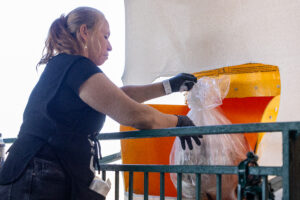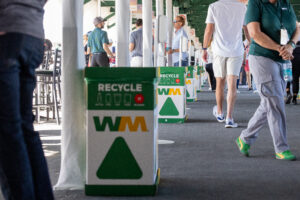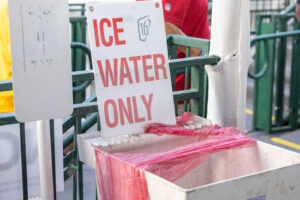- Slug: Phoenix Open Sustainability. 880 words.
- Photo available.
By Jackson Shaw
Cronkite News
SCOTTSDALE – The 16th hole at the WM Phoenix Open is coined “the loudest hole in golf.” Rowdy fans fill the stands in the coliseum surrounding the green as some of the best golfers in the world make their way through Arizona’s popular stop on the PGA Tour.
It might also be “the most sustainable.” Consider this: Surrounding that hole are sinks where all of the melted ice from leftover drinks and the bars are dumped. The water flows into holding tanks down below, where a truck pumps out the fresh water, which then goes around and uses the water to activate the sanitizer tablets in the restrooms.
“You just need a little bit of water, but it’s a way that we save thousands of gallons of water,” said Chad Bowden, WM Phoenix Open operations manager.
Waste Management, the title sponsor of the WM Phoenix Open, continues to provide and develop new opportunities for enviromental conservation as years progress. For the eighth consecutive year, the Open has achieved the Golf Environment Organization tournament certification. It was the first PGA Tour tournament to achieve the certification. On Saturday, also known as “Green Out Day,” for every person wearing green, one dollar will be donated to the WM Phoenix Open Working for Tomorrow Fund. In 2024, fans helped raise $170,000 on Green Out Day.
Given the mass amount of fans that roam about TPC Scottsdale’s various concession areas, especially at and around the 16th hole, there is much that goes on behind the scenes to ensure that all waste is disposed of properly.
Surrounded by a stadium-like atmosphere, fans are spoiled with a great view of the green, but what they may not see is the efforts Waste Management goes to every year for its commitment to environmental conservation. Spread across the entirety of the Open, there are 16 trash compactors designed for recycling and 13 for compost. On the 16th hole alone, there are six compactors (three for recycling and three for compost), each of which hold approximately six tons of material.
“We have 4,800 bins out on the course, and we have a staff of 600 temporary employees with 85 managers from across WM that help us achieve this zero waste event,” said Bowden, whose role is to ensure that the zone managers and the temporary workers are educated and understand where the material needs to be and how to process it so it ends up in the right end facility.
“A lot of education goes in with the vendors that supply things here, because they have to bring the right things that are compostable, recyclable … to make sure nothing ends up in a landfill,” he said.
Trash chutes are dispersed among the many food and drink vendors at each of the three levels of the 16th hole stadium. The trash is disposed of into these chutes, which all lead directly to the compactors beneath the building.
Last year, about 750 tons of recycle and around 80 tons of compost were collected for the week, Bowden said. Across the entire course, green and yellow labeled trash bins make it easy for attendees to determine where to throw away their trash, which makes it easier for the staff to sort out all the material behind the scenes.
All across this year’s tournament, spectators can be found holding green plastic cups, an active demonstration of a reusable cup program WM is piloting this year. The program, which is made possible through a local company called “Bold Reuse,” will divert an estimated 32,000 cups from having to be recycled through washing and reuse.
Additionally, there is white scrim all around the structures at the Open. At the end of the tournament, that scrim is taken down, melted into pellets, and is used to make WM trash containers for everyday collection.
Most fans are unaware. Their focus is on golfers including Justin Thomas, Hideki Matsuyama, Sam Burns and 2023 winner and World No. 1 Scottie Scheffler. Fans come from all over the world and show up as soon as the gates open at 7 a.m. to get as close as they can to the action. And for some, there is no better place to be than hole 16, even though most are unaware of the focus on sustainability there.
“The only place I want to be,” said John Oliva, a local fan from the Valley making the most of his general admission ticket at the 16th hole. “This is the only place that I want to be at this golf course.”
For a particular group of people dressed as ears of corn (green and white checkered overalls with corn on the cob button-ups), it’s their fifth time coming to the WM Phoenix Open. But for the Urlacher brothers, it’s their first time making the trip from Alberta, Canada, all the way down to Scottsdale for the Open.
“It’s unreal … Which way our ball would go, I’m not sure, so it’s impressive to see what they do,” the two said while looking out onto the infamous 16th hole.
Given the mass amount of fans that roam about TPC Scottsdale’s various concession areas, especially at and around the 16th hole, there is much that goes on behind the scenes to ensure that all waste is disposed of properly.
“While things maybe aren’t always the easiest, we’re always looking for new ways to have a positive environmental impact and we do a lot of that research here at this tournament,” Bowden said.
For more stories from Cronkite News, visit cronkitenews.azpbs.org.


